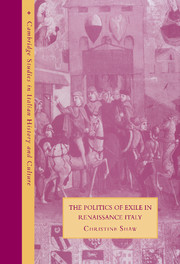7 - Going home
Published online by Cambridge University Press: 31 July 2009
Summary
‘The man who is in exile’, Giovanni Severini warned the Balìa of Siena in March 1483, ‘thinks of nothing but returning home, just as a sick man thinks of nothing but being well again.’ Severini may well have been speaking from personal experience: he had only returned from two years in exile nine months earlier. Many exiles were destined to die with their dreams of return unfulfilled. Only the deaths of the most prominent would be noted, like that of Guido Rossi from Parma, dying in the Veneto; Palla Strozzi, dying at the age of ninety an honoured citizen of Padua; or Piero de' Medici, drowning as he tried to cross a river with French forces in the kingdom of Naples. Antonio Caldora, who had been the viceroy of René d'Anjou in Naples, died in obscure and impoverished old age at Jesi; Antonello da Sanseverino, the most powerful of a later generation of Neapolitan barons, of disease at the age of forty-three near Senigallia, where he had gone to seek the hospitality of his brother-in-law, Giovanni della Rovere. Some of those who died in exile could have returned had they chosen to do so, but did not, either because of fear that they would not be safe, or dislike for the regime they would have to live under, or because they had made a new life for themselves elsewhere.
- Type
- Chapter
- Information
- The Politics of Exile in Renaissance Italy , pp. 203 - 233Publisher: Cambridge University PressPrint publication year: 2000

